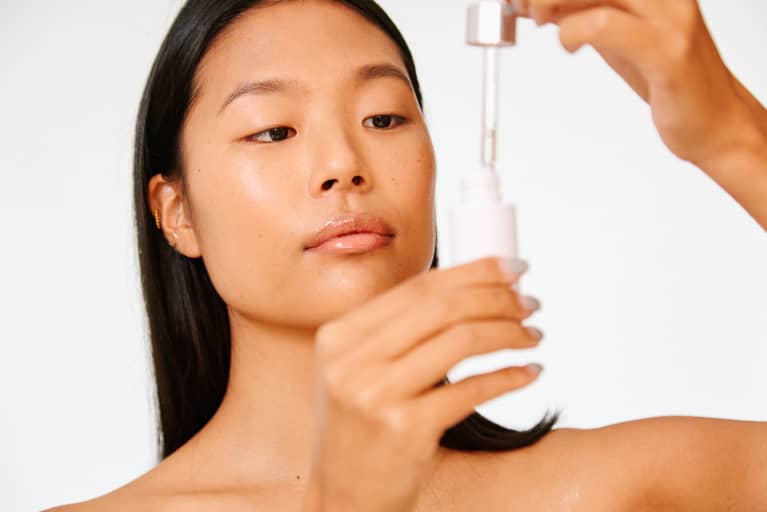Niacinamide First Or Vitamin C
Niacinamide & Vitamin C: Friends Or Foes? Derms Explain How To Layer Them

Our editors have independently chosen the products listed on this page. If you purchase something mentioned in this article, we may earn a small commission.
Ask any derm, esthetician, or beauty editor about their daily skin care routine, and chances are they'll name-drop niacinamide (aka vitamin B3) and vitamin C pretty early on in the conversation. They are the ultimate crowd-pleasers, after all: Each ingredient has an impressive résumé of benefits with—quite literally—glowing reviews.
Since they're so beloved in skin care, you may be wondering: Can you use niacinamide and vitamin C together? Or are the two formulas more like frenemies—seemingly tolerable but way too competitive to ever have a meaningful relationship? Ahead, experts weigh in.
Vitamin C.
First, let's review some of the highlights of each buzzy ingredient. We'll start with vitamin C:
- Fades dark spots and helps even skin tone: This is perhaps the most famous benefit. Using vitamin C topically has been shown to help overall quality and tone by diminishing hyperpigmentation and brightening the complexion.
- Plays a vital role in collagen production: Vitamin C doesn't just stimulate collagen production; it stabilizes the collagen you already have, leading to overall wrinkle reduction. Take it from board-certified dermatologist Julia T. Hunter, M.D., founder of Wholistic Dermatology in Beverly Hills: "If you don't have vitamin C, your collagen can't cross-link to lift and tighten skin," she tells us about the ingredient.
- Helps fight oxidative stress: Because vitamin C is a potent antioxidant, it can fend off free radicals and support a balanced inflammatory response in the skin; research has even shown it can help against UV-induced photodamage.
See here for our full list of benefits.
Niacinamide
Ahead, find praise for the highly esteemed vitamin B3:
- Tackles hyperpigmentation: "When applied topically, niacinamide helps reduce the appearance of brown spots, blotchiness, and redness and brightens the overall complexion," board-certified dermatologist Caren Campbell, M.D., previously told mbg.
- Helps treat acne: One study showed that applying a topical formula of 4% niacinamide treated moderate acne just as well as 1% of the topical antibiotic clindamycin.
- Helps soften fine lines: "It helps prevent and treat signs of aging due to reactive oxygen species, which typically break up collagen and elastin and can result in sagging wrinkles in skin," says Campbell. And various studies have shown that applying vitamin B topically also helped produce new skin cells and improve elasticity in the skin.
Find our full guide to niacinamide here, as well as the best niacinamide serums (if you're in the market).
Can you use them together?
Short, basic answer? Yes! As you likely noticed above, niacinamide actually carries similar benefits to vitamin C, anyway. The two ingredients can even complement each other, which is why you may find niacinamide and stable forms of vitamin C in the same skin-brightening product (our recommendations, below).
Here's where things get hairy: Older research has shown that mixing vitamin C—specifically the unstable ascorbic acid—with niacinamide can convert it to the compound niacin, which can cause flushing (think blotchy, inflamed skin).
However, the science may be a bit overstated: It actually takes extremely high heat for the two ingredients to convert to niacin, which is unlikely to happen in skin care formulations. That older study used nonstabilized forms of both ingredients in a high-temperature environment—one that did not represent typical skin care products in development, manufacturing, or in real-world storage and usage.
If you're at all worried, though, many experts (including board-certified internist and holistic skin care expert Zion Ko Lamm, M.D., in a TikTok video) advise to proceed with caution when layering the two ingredients, especially if your skin is already sensitive to niacinamide itself.
The bottom line? It is possible that combining niacinamide and vitamin C can convert to niacin and cause flushing, but it would need to be exposed to a super-high heat to get to that point. Skin care formulations don't tend to reach those levels of heat, so you should be just fine—but if your skin falls more on the sensitive side, you might still want to proceed with caution. And if you do have sensitive skin, you might want to use low concentrations of niacinamide, typically no greater than 2%, to avoid irritation.
How to layer them both.
If you're interested in using both actives, here's how to make sure they don't cancel each other out—or cause irritation:
1. Use your vitamin C serum first, and let it dry.
Since vitamin C is notoriously unstable, you always want to apply it on clean, dry skin. Then "Let vitamin C completely dry prior to placing niacinamide," says Lamm. That way, the ascorbic acid has a chance to settle into the skin, and there's a smaller chance of combining the two actives. Board-certified dermatologist Jennifer Herrmann, M.D., seconds the advice: "It takes a bit of time for products to absorb. The skin should appear dry before applying the next product," she once told us about layering serums.
Although, you should always apply your skin care products from thinnest to thickest: So, say, if you have a niacinamide serum and a vitamin-C-infused moisturizer, apply the serum first, then follow up with the cream.
2. Find a product with both ingredients.
To make things easier, you can always find a product that incorporates both vitamin C and niacinamide, like this Daily Dose serum from epi.logic or this Triple Active Reclaiming Serum from January Labs.
3. Use niacinamide in your moisturizer.
"One of niacinamide's greatest strengths is that it can play nice with everyone. Instead of dedicating a whole product step to a niacinamide serum, consider a chemist-favorite move and leave niacinamide to your moisturizer," cosmetic chemists Victoria Fu and Gloria Lu previously shared with mbg.
Since niacinamide pairs so well with other ingredients (unlike vitamin C), you may be better off sticking to a pure vitamin C serum, then following up with a hydrating moisturizer that contains niacinamide—you won't have to worry about the niacinamide not doing its job since it's pretty stable overall.
The takeaway.
Yes, you can use both vitamin C and niacinamide, but mind the above tips so you don't end up canceling the ingredients out. Layer them correctly, though, and you may even punch up their purported benefits.
You are now subscribed
Be on the lookout for a welcome email in your inbox!
A Modern Approach to Ayurveda
With Sahara Rose

More Lifestyle
Popular Stories
https://www.mindbodygreen.com/articles/niacinamide-and-vitamin-c
In order to save this article, you will need to Log In or Sign Up!
Close
Niacinamide First Or Vitamin C
Source: https://www.mindbodygreen.com/articles/niacinamide-and-vitamin-c#:~:text=Use%20your%20vitamin%20C%20serum,placing%20niacinamide%2C%22%20says%20Lamm.&text=The%20skin%20should%20appear%20dry,told%20us%20about%20layering%20serums.

0 Komentar